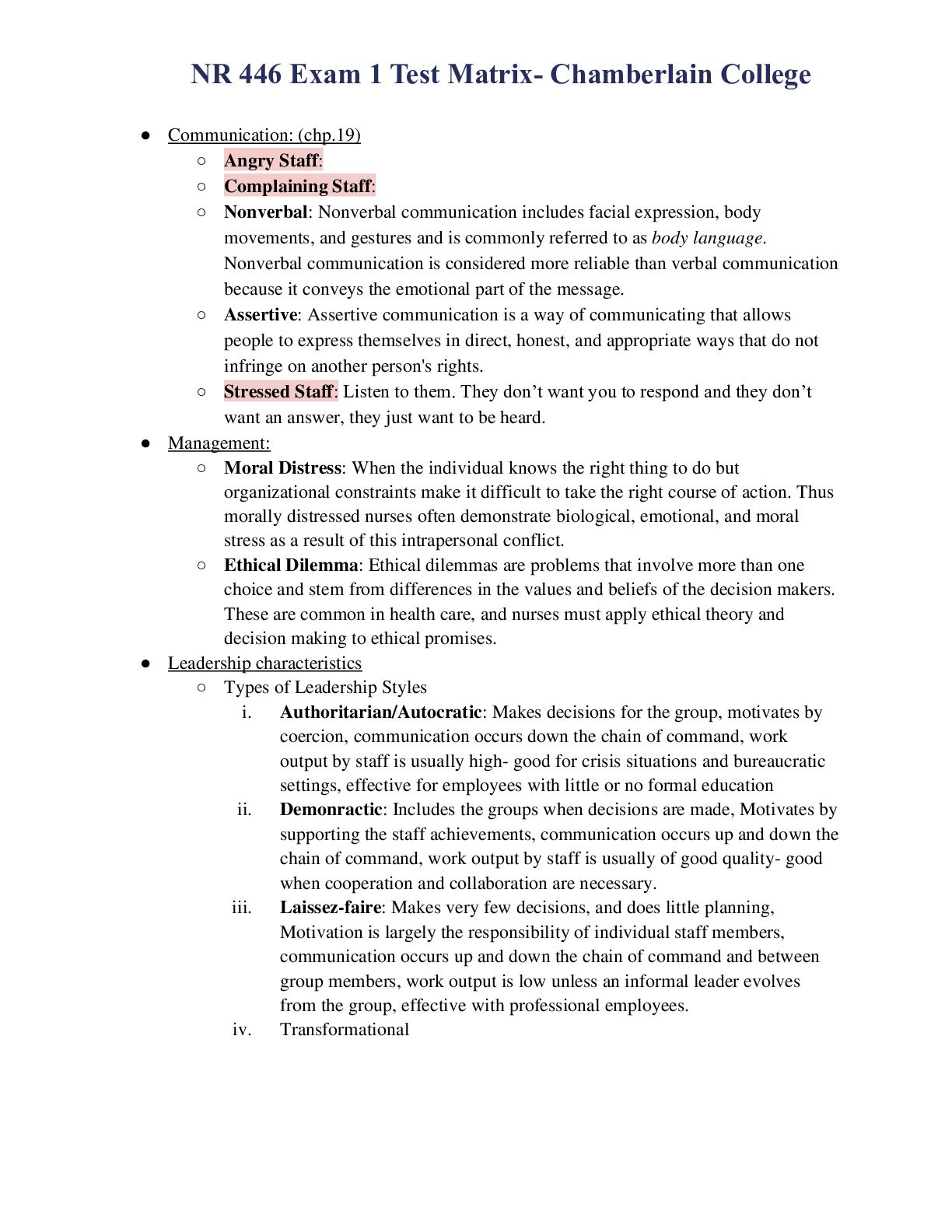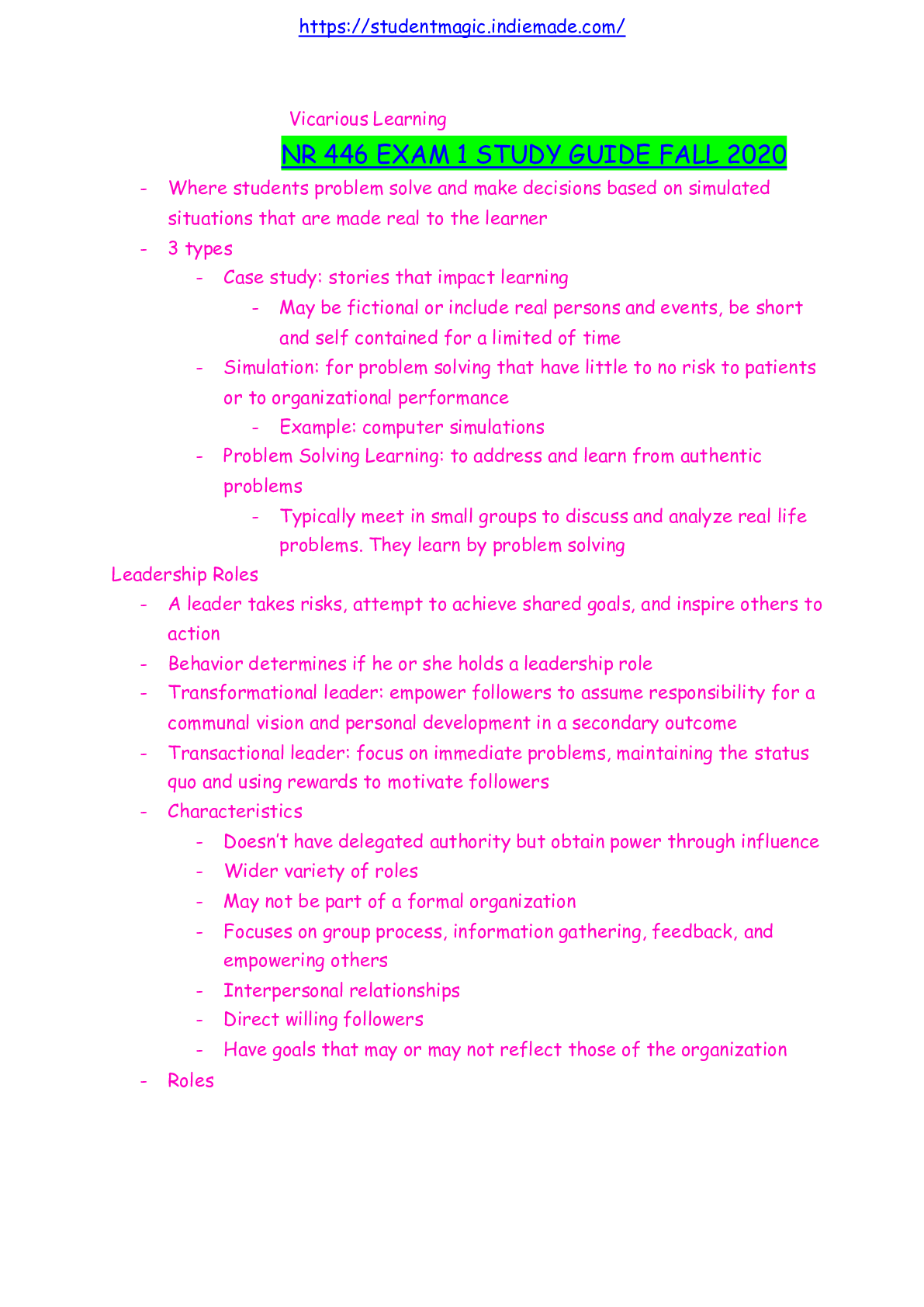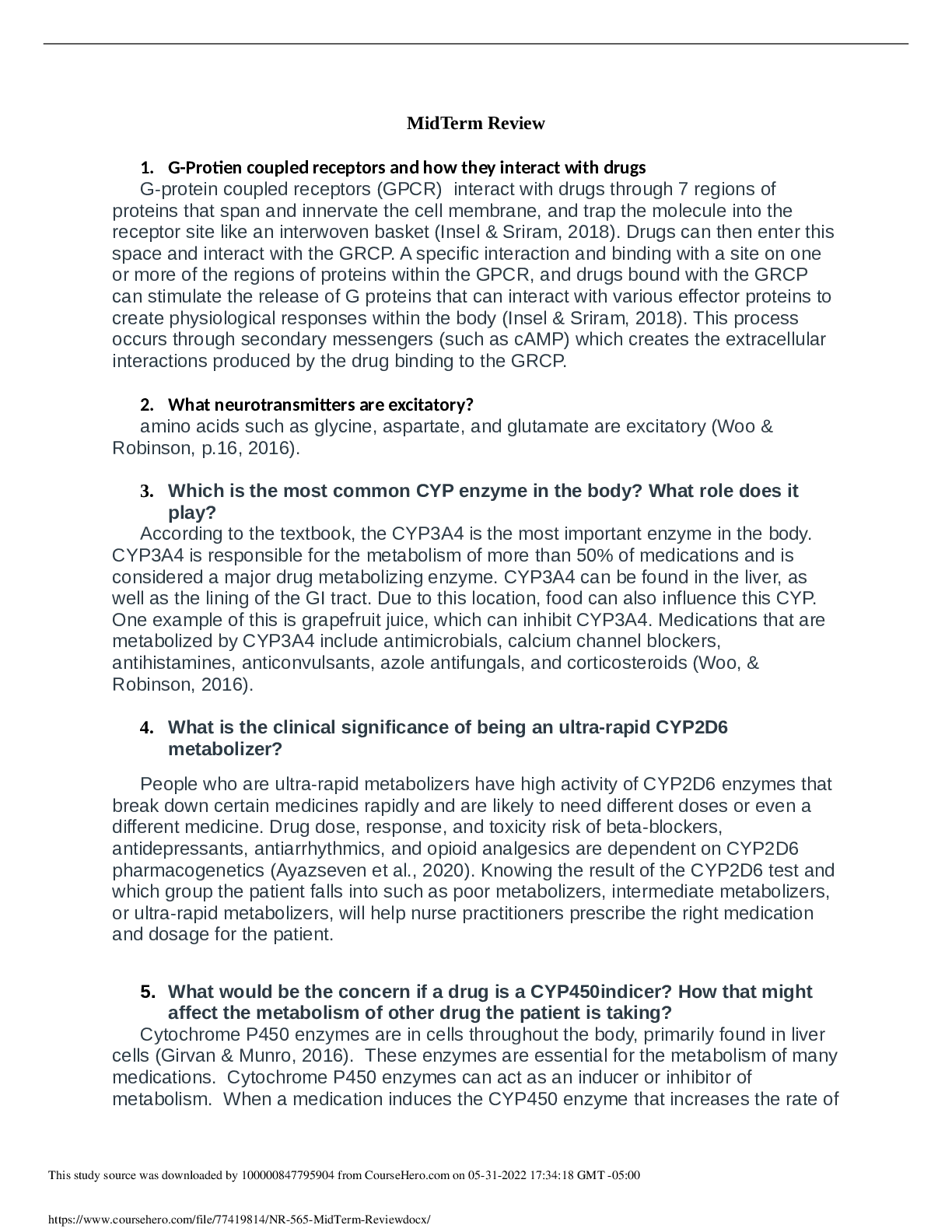Chamberlain College of Nursing: NR 446 Exam 1 Review,100% CORRECT
Document Content and Description Below
Chamberlain College of Nursing: NR 446 Exam 1 Review ❖ Nursing process o The weakness of the nursing process, like the traditional problem-solving model, is in not requiring clearly stated obj... ectives. Goals should be clearly stated in the planning phase of the process, but this step is frequently omitted or obscured. ❖ Role of the nurse as a client advocate Advocacy • Advocacy involves helping others to grow and self-actualize • Nurses must advocate for themselves, clients, subordinates, and their profession • Advocates must inform others of their rights and make sure they have enough information to make informed decisions • Advocacy is defined as protecting and defending what one believes in for both self and others Nursing Values Central to Advocacy 1. Each individual has a right to autonomy in deciding what course of action is most appropriate to meet his or her health-care goals 2. Each individual has a right to hold personal values and to use those values in making health- care decisions 3. All individuals should have access to the information they need to make informed decisions and choices 4. The nurse must act on behalf of patients who are unable to advocate for themselves 5. Empowerment of patients and subordinates to make decisions and take action on their own is the essence of advocacy How Nurses Can Act as Advocates • Helping others make informed decisions • Acting as intermediaries in the environment • Directly intervening on behalf of others • Advocating for social justice Controlling Patient Choices versus Assisting Patient Choices ▪ It is important for the patient advocate to be able to differentiate between controlling patient choices (domination and dependence) and assisting patient choices (allowing freedom) ▪ Allowing the patient to make his/her decision after he/she has been giving all necessary information that could help in making the choice. Advocating for Patients as Managers • Creating a work environment that recognizes patients’ needs and goals as paramount • Creating a work culture in which patients are respected, well informed, and empowered • Advocating for patients with regard to distribution of resources and the use of technology • Taking risks particularly when advocating for a client may be in direct conflict with a provider or institutional goal Common Areas Requiring Nurse–Patient Advocacy • End-of-life decisions; aging populations • Technological advances • Health-care reimbursement • Access to health care • Provider–patient conflicts • Withholding of information • Insurance authorization • Medical errors • Patient information disclosure • Patient grievance and appeals process • Culture and ethnic diversity and sensitivity • Respect for patient dignity • Inadequate consents; complex social problems • Incompetent health-care providers ❖ Nursing intervention - Antihypertension medications, anticonvulsant medications (e.g. clonazepam) o Priority nursing diagnosis for a client taking an antihypertensive medication Alteration in cardiac output related to effects on the sympathetic nervous system o Instruct patients that htn drugs should not be stopped abruptly because this causes rebound htn and could lead to stroke. Remind patients that meds are only part of therapy; encourage patients to watch diet o Clonazepam ▪ Change LOC, sweating, diaphoresis, tachycardia ▪ Contradiction with pregnancy ▪ Life threatening or dangerous side effects: respiratory depression, hepatic dysfunction, renal dysfunction, seizures ▪ Monitor for S&S of overdose, including somnolence, confusion, irritability, sweating, muscle and abdominal cramps, diminished reflexes, coma. ▪ Should not discontinued suddenly because they may cause insomnia or seizures ▪ Avoid sunlight and tanning beds ❖ Decision-making process o Decision-making models offer analytical tools to provide useful insights when making decisions. The nursing process is a very useful and effective process that is used as a guide for decision making and problem solving when addressing patient care needs and nursing accountability. This process can be easily adapted to all management and leadership activities requiring decision making and problem solving. The nurse in a leadership position is required to make many decisions, ranging from assigning staff to calling a code on a nonbreathing client. Therefore, whatever leadership model is being used, the nurse should be able to make and communicate competent decisions. o Rational, Normative: Nurses make clinical decisions using different approaches. The rationalist approach involves an analysis of a situation so that subsequent actions are rational, logical, and based on knowledge and judgments. It consists of a structured four-step sequence. ▪ Problem identification ▪ Formulate another solution ▪ Implement the chosen solution ▪ Evaluate the solution o Group Decision-Making Model: The leader presents the problem to the group and all of the members are asked to contribute and make suggestions. The leader makes the decision alone, choosing to use or discard information obtained from the group. ▪ Advantages 1. Groups have more ideas and a broader perspective and are more knowledgeable. 2. Participants are more satisfied with the decision and are more likely to support it. ▪ Disadvantages 1. It is time-consuming. 2. It can be wasteful and unproductive if not managed effectively. 3. It can be costly. 4. It can generate conflict. o Critical Thinking Model: The leader approaches group members individually and presents them with the problem. The leader records the group members’ suggestions and makes a decision, deciding whether or not to use the information provided by the group members. Nurses are expected to have higher order thinking skills to identify patient problems and to direct clinical judgments and actions that result in positive patient outcomes. ❖ Policy & Procedure for (e.g. Code Red); o Code orange – bomb threat o Code blue – cardiac arrest o Code black – disaster (internal or external) o Code red – fire (the most urgent) ❖ Policy concerning DNR o A DNR order only controls CPR and similar life-saving treatments o The nurses will continue to implement all treatments focused on comfort and symptom management ❖ RACE o Rescue o Alarm o Close/contain o Extinguish ❖ Decision-making process/Problem solving/critical thinking ❖ Leadership and Management role/Leaders’ role and managers’ role; Traditional style of leadership/management o Leadership versus Management ▪ Leaders • Empower others; maximize workforce effectiveness • Needed to implement the planned change that is part of system improvement • Leadership is the art of getting work done through others willingly ▪ Managers • Leaders are in the front, moving forward, taking risks and challenging the status quo • A job title alone does not make a person a leader. Only a person’s behavior determines if he or she occupies a leadership position • Guide, direct, and motivate others • Intervene when goals are threatened • Emphasize control o Managers and Leaders ▪ Leaders ▪ Managers • Often do not have delegated authority, but obtain their power through other means • Have a wider variety of roles than managers and may have different personal goals • Are frequently not part of the formal organization • Focus on group process, information gathering, feedback, and empowering others • Are always assigned a position within an organization • Have a legitimate source of power due to the delegated authority that accompanies their position • Are expected to carry out specific function. • Emphasize control, decision making, decision analysis, and results ❖ HIPAA Guidelines, rules, and regulations ❖ Legal issues: Torts - Defamation, slander, libel, assault, battery, & invasion of privacy o Assault (verbal, threat) o Battery (physical in nature, contact) o Invasion of privacy o Defamation of character ▪ Slander (spoken) ▪ Libel (written) ❖ Inform Consent – Consent is required for all care given in a healthcare facility. The patient signs a consent form for treatment on admission to the healthcare agency. However, this consent represents the patient consenting to be treated in that facility by the healthcare personnel working there. It does not imply that the patient has been informed and has agreed to every specific treatment that is ordered by the physician or healthcare team. That's why, with each new order, treatment plan, or special procedure, the patient must be informed of the action, its purpose, its risks, and its benefits. It also includes explanation of the consequences if the treatment or procedure is not done. Remember, it is the nurse's role to assess the patient's understanding of procedures and treatments. When there is lack of understanding, the nurse must involve other members of the healthcare team to help inform the patient. For example, a patient is to have a surgical procedure. While obtaining the patient's signature on the informed consent, the nurse finds the patient is confused about the procedure. The nurse would not obtain the signature until after the physician had clarified the procedure with the patient. o The person(s) giving consent must fully comprehend ▪ The procedure to be performed ▪ The risks involved ▪ Expected or desired outcomes ▪ Expected complications or side effects that may occur as a result of treatment ▪ Alternative treatments that are available o Consent may be given by ▪ A competent adult ▪ A legal guardian or individual holding durable power of attorney ▪ An emancipated or married minor ▪ Mature minor (varies by state) ▪ Parent of a minor child ▪ Court order ❖ Preventing malpractice and error o Practice within the scope of nursing practice act o Observe agency policies and procedures o Model practice after established standards by using evidence-based practice o Always put patient’s rights and welfare first o Be aware of relevant law and legal doctrines o Practice within the area of individual competence and upgrade technical skills consistently ❖ Necessary steps to prevent error. ❖ How do you prepare inform consent with an immigrant/non-English speaking o Interpreter ❖ Determining when to initiate Incident Report and appropriate contents to include in the incident report form o Records of unusual or unexpected incidents that occur in the course of a client’s treatment o Generally considered confidential communications and cannot be subpoenaed by clients or used as evidence in their lawsuits in most states o A copy of an incident report should not be left in the chart, and no entry should be made in the patient’s record about the existence of an incident report ❖ Communication with non-English speaking client. o Interpreter ❖ Incident report – (e.g. issues that required incident report). ❖ Advance Directives (Living will etc) o Under the federal law an advance directive is a written instruction, such as a living will or durable power of attorney for health care recognized under state law relating to the provision of health care when the individual is incapacitated. Advance directive describes the kind of treatment you would want depending on how sick you are. Individuals who are seriously or terminally ill are more likely to have an advance directive" (Marquis & Huston, 2014). For example, someone with terminal cancer might not want to be put on a respirator if she or he stops breathing. This action can reduce suffering, increase the individual’s peace of mind, and increase his or her control over death. However, even if the individual is in good health, he or she might want to consider writing an advance directive. An accident or serious illness can happen suddenly, and if there is a signed advance directive, then the individual's wishes are more likely to be followed. o Advance directives can take many forms; do not resuscitate (DNR) is another kind of advance directive. A DNR is a request to not have cardiopulmonary resuscitation (CPR) if an individual stops breathing. Unless given other instructions, hospital staff will try to help any patient whose heart has stopped or who has stopped breathing. Doctors and hospitals in all states must accept and follow DNR orders. Laws about advance directives are different in each state; therefore, all nurses should be aware of the laws in their states. o How should the new nurse determine if an 84-year-old woman is capable of giving an informed advanced directive? Most organizations will have policies on this that will guide the nurse in understanding the rights of the woman in this matter. It is important for the nurse to know that a living will can be revoked if it was enacted when the individual was not competent and the condition is not terminal (Cherry & Jacob, 2011). o A living will is invoked only when the client has a terminal condition or is in a persistent vegetative state o A living will directs the client's healthcare in the event of a terminal illness or condition. A durable power of attorney is invoked when the client is no longer able to make decisions on his or her own behalf. The client may change an advance directive at any time. ❖ Ethical Dilemma; Ethic Committee (e.g. what is the role of the Ethic Committee) o Ethical dilemma – described as being forced to choose between two or more undesirable alternatives o Collaborate through ethics committees – they assist with problem solving in ethical issue ❖ HIPAA rules & regulations, and Confidentiality. ❖ Health care laws/Legal laws Sources of Law Description Example Application to Nursing Practice Constitution/Federal The highest law in the Diagnosis-related Forced hospitals to United States; interpreted groups (DRGs) reduce patient length of area of malpractice by the Renal Disease stay and led to U.S. Supreme Court; gives Program (1972) development of new authority to other three providing funding nursing roles, such as sources of the law for kidney failure Medicare Program in 1965 case management Led to new area of nursing specialty practice of nephrology Increases in hospitalization of older adults' need for nurses in acute settings. Statutes Called statutory law and passed by the state or federal legislature or city council and must be signed by the president or governor State Nurse Practice Act Board of Nursing Rules and Regulations Child Abuse Reporting and Prevention Act Domestic Violence reporting Nurse Practice Act determines and limits the scope of practice of nursing. Monitors for valid, current, and appropriate license to practice nursing Regulation of practice protects the public. Laws created for nurses to report specific health problems and suspected child abuse. Failure to report can result in criminal charges. Court Decisions Also called tort law, this is court made. The courts interpret the statutes and set precedents. The body of written opinion about nursing is known as nursing case law. Nursing malpractice cases Role as patient advocate Duty to prevent harm Most malpractice law is addressed by the courts. Nurses must understand the effect of nursing court law on current practice. ❖ Safety - Patient care (e.g. Radiation treatment); use of disinfectants such as cleaning solution; Sterile dressing change (know the appropriate steps). ❖ Therapeutic communication – understand Respite care o Respite care is a service that provides short-term relief or “time off” for people providing home care to an ill, disables, or frail older adult o Respite care is offered in the home, a day care setting, or a health care institution that provides overnight care. ❖ Legal issues, Legal documents. Witnessing a Living Will (e.g. Who should not be a witness) ❖ Client Neglect/negligence o Negligence is unintentional tort ❖ Policy & procedure ❖ ❖ Client teaching – Organ donation ❖ ❖ Leadership styles ▪ Authoritarian ▪ Democratic ▪ Laissez-faire ❖ Nurses’ Legal obligation to patient ❖ ❖ Problem solving process ❖ ❖ Nursing scope of practice o 1 Assessment: The registered nurse collects comprehensive data pertinent to the patient's health and/or the situation. o 2 Diagnosis: The registered nurse analyzes the assessment data to determine the diagnoses or issues. o 3 Outcomes Identification: The registered nurse identifies expected outcomes for a plan individualized to the patient or the situation. o 4 Planning: The registered nurse develops a plan that prescribes strategies and alternatives to attain expected outcomes. o 5 Implementation: The registered nurse implements the identified plan. o 5a Coordination of Care: The registered nurse coordinates care delivery. o 5b Health Teaching and Health Promotion: The registered nurse uses strategies to promote health and a safe environment. o 5c Consultation: The graduate level–prepared specialty nurse or advanced practice registered nurse provides consultation to influence the identified plan, enhance the abilities of others, and effect change. o 5d Prescriptive authority and treatment: The advanced practice registered nurse uses prescriptive authority, procedures, referrals, treatment, and therapies in accordance with state and federal laws and regulations. o 6 Evaluation: The registered nurse evaluates progress toward attainment of outcomes. ❖ Nursing & the Media o Be prepared o Stick to three or four key points o Provide the media with clear, concise information o Stay on track by sticking to predetermined points o Do not be afraid to say that you do not have enough information or expertise to answer a question ❖ Malpractice ▪ Standards of practice require a complete assessment. A nurse needs to be sure the client’s needs have been met. They both can impact client safety and do not follow standards of care. ▪ The failure of a person with professional training to act in a reasonable and prudent manner – also called professional negligence ❖ Medical Records ▪ The only person entitle to information without written consent is the client and those providing direct care. The nurse has open access to information regarding assigned clients only. ▪ The patient has a right to privacy of any personal, medical, financial, or any other information contained in the medical record. This right is protected by the Health Insurance Portability & Accountability Act (HIPAA) [Show More]
Last updated: 1 year ago
Preview 1 out of 23 pages
Instant download

Buy this document to get the full access instantly
Instant Download Access after purchase
Add to cartInstant download
Reviews( 0 )
Document information
Connected school, study & course
About the document
Uploaded On
Jul 26, 2022
Number of pages
23
Written in
Additional information
This document has been written for:
Uploaded
Jul 26, 2022
Downloads
0
Views
54






















